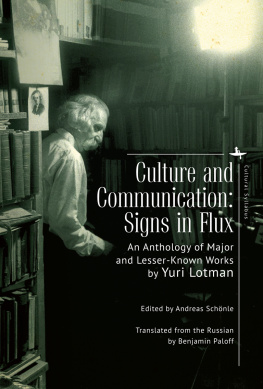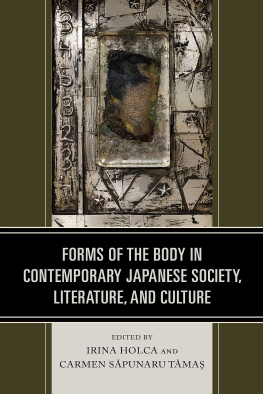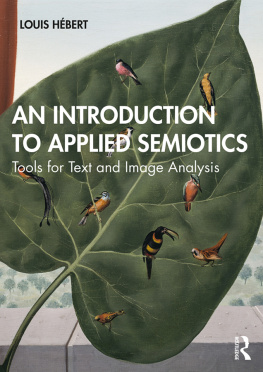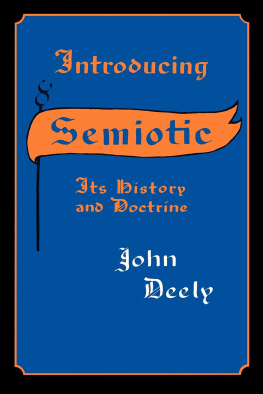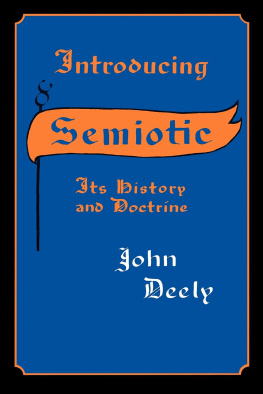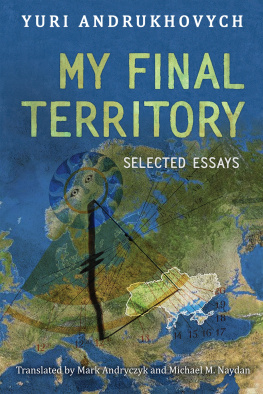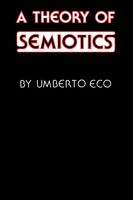Table of Contents
Cultural Syllabus
Series Editor
Mark Lipovetsky (Columbia University)
Culture and
Communication:
Signs in Flux
An Anthology of Major
and Lesser-Known Works
by Yuri Lotman
Edited by Andreas Schnle
Translated from the Russian
by Benjamin Paloff
BOSTON
2020
The publication of this book is supported by the grant from the TRANSKRIPT program of the Mikhail Prokhorov Foundation.
Originals: Yuri Lotman estate, Estonian Semiotics Repository Foundation (Eesti Semiootikavaramu), all rights reserved. Published by arrangement with ELKOST Intl. Literary Agency, Barcelona, Spain.
Collection: Academic Studies Press
Library of Congress Cataloging-in-Publication Data
Names: Lotman,  . M. (
. M. ( ri Mikhalovich), 19221993, author. | Schnle, Andreas, editor. | Paloff, Benjamin, translator.
ri Mikhalovich), 19221993, author. | Schnle, Andreas, editor. | Paloff, Benjamin, translator.
Title: Culture and communication: signs in flux: an anthology of major and lesser-known works/by Yuri Lotman; edited by Andreas Schnle; translated from the Russian by Benjamin Paloff.
Description: Boston: Academic Studies Press, 2020. | Series: Cultural syllabus | Includes bibliographical references.
Identifiers: LCCN 2020011311 (print) | LCCN 2020011312 (ebook) | ISBN 9781644693865 (hardback) | ISBN 9781644693872 (paperback) | ISBN 9781644693889 (adobe pdf)
Subjects: LCSH: Semiotics. | Culture--Semiotic models.
Classification: LCC P99 .L6625 2020 (print) | LCC P99 (ebook) | DDC 401/.4--dc23
LC record available at https://lccn.loc.gov/2020011311
LC ebook record available at https://lccn.loc.gov/2020011312
ISBN 9781644693865 hardback
ISBN 9781644693872 paperback
ISBN 9781644693889 ebook PDF
ISBN 9781644693896 ePub
Cover design by Ivan Grave
On the cover: Photograph by Malev Toom, Tartu Art Museum, Contemporary Art Collection. Reproduced by permission
Book design by PHi Business Solutions
Published by Academic Studies Press
1577 Beacon Street
Brookline, MA 02446, USA
press@ academicstudiespress.com
www.academicstudiespress.com
Acknowledgments
W e wish to express our gratitude to friends and colleagues who have helped shape and facilitate this project at various stages: Jonathan Bolton, Marina Grishakova, Mark Lipovetsky, Mikhail Lotman, William Mills Todd III, B. A. Uspensky as well as our two anonymous peer reviewers.
Thanks are also due to the supportive editorial team at Academic Studies Press, who have encouraged this project at every stage, including Jenna Colozza, Oleh Kotsyuba, Igor Nemirkovsky, Kira Nemirovsky, Faith Stein, and Ekaterina Yanduganova.
We are grateful to the Yuri Lotman Estate, Estonian Semiotics Repository Foundation (Eesti Semiootikavaramu) for the right to translate the texts included in this volume.
A Note on the Text
L otmans original notes are reproduced here as endnotes referenced by Arabic numerals. We used footnotes, referenced by Roman numerals, for our editorial comments. Each article is introduced by a brief paragraph in italics explaining its source and significance, as well as placing it in a larger critical context.
The articles included in this collection reflect various scholarly styles, including some pieces that were initially presented as television programs and that accordingly present a more conversational style, with lighter referencing. Our translation has aimed to retain these inflections of tone and style.
A Note on Transliteration
T his volume uses two different transliteration systems. For proper names occurring within the text, we have either used well-established English equivalents or applied simplified and anglicized spelling, writing, for example, Veselovsky instead of Veselovskii and Alexander instead of Aleksandr. In bibliographic references, we have consistently used the Library of Congress transliteration, even for proper names.
Introduction
ANDREAS SCHNLE
Y uri Lotman (19221993) is one of the most prominent and influential Russian scholars of the twentieth century. This conception took hold not the least because it resonated with Russian cultures recurrent valorization of art as an existential project, the notion that art formulates not only aesthetic values, but also desirable ways of living.
Lotman was both a theorist and a historian. His uncanny command of Russian print culture not only enabled him to introduce substantial revisions to Russias historiographic paradigms, transforming the ways in which his readers thought of Russias identity, but also stoked one of his most endearing talentshis knack for pointing to unexpected, poorly known facts of Russian and, sometimes, world culture in support of a theoretical position. Indeed, perhaps his greatest asset was the ability to underpin history with theory and substantiate theory with history, casting a new light on everything he touched. He was a daring and imaginative thinker. He did not shy away from speculation and sometimes was prone to confusing his erudition with a license to conjecture. His skill at finding patterns and subtexts, honed on the practice of literary analysis, served him less well when applied to social behavior: some of his last historiographic ventures (for example, his richly contextual biography of Nikolay Karamzin) smack of overreading. Yet, his theoretical investigation of the role of chance and unpredictability in history and culture, which he presented in his last theoretical book, Culture and Explosion [Kultura i vzryv], tempered this penchant for overdetermination. He died before he could consider how this new premise would transform his interpretations of distinct episodes of Russian literature and culture.
In many ways his career offered a palimpsest of his times. After serving six years in the army, including four in combat during World War II, Lotman came back a decorated soldier, one of an estimated five percent of the enlisted men born in 1922 to survive the war. For the same reason, he experienced difficulties finding a job, until he landed a position as teacher of Russian literature in a two-year pedagogical institute in Tartu, Estonia. Annexed in 1940, the fifteenth Soviet republic needed russification, and local authorities did not deem Lotmans ethnicity a liability. Becoming a resident of Estonia proved to be a blessing in disguise. Lotman quickly began to teach classes in the Department of Russian Literature at Tartu University. In 1952, he finally was able to defend his dissertation at Leningrad University. By 1954, he was a regular faculty member at Tartu University. While ostensibly marginalized by this displacement from the two capitals, Lotman took advantage of the comparatively more relaxed atmosphere of Estonian intellectual life and progressively built the Department of Russian Literature into a pioneering theoretical and historical powerhouse.
In the 1950s Lotman worked on a reconceptualization of late eighteenth- and early nineteenth-century intellectual and literary history. Inspired by the emergence of structuralism in Moscow, he began publishing on theoretical issues in 1962 and the following year made contacts with Moscow colleagues.
Since then, Estonian and Russian academic circles have engaged in a lively and spirited reevaluation of Lotmans legacy. While his colleagues and former students at Tartu continued to work broadly within his conceptual frameworks, two different lines of succession coalesced institutionally and methodologically. Work on semiotics proceeded apace in the Department of Semiotics at the University of Tartu, while work on Russian cultural history was carried forward in the Department of Slavic Studies. This division reflected a breakdown of the unique synthesis between history and theory Lotman had attempted, as literary and cultural historians in the 1990s and 2000s in Russia engaged in much more empiricist, text- and archive-based, and theory-adverse studies. Lotmans semiotic legacy found a home on the pages of

